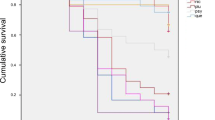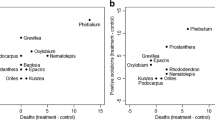Abstract
Variation in susceptibility of 28 Prunus rootstock genotypes to the causal agents of Armillaria root rot, Armillaria mellea, A. solidipes, and Desarmillaria tabescens, were studied by conducting in vitro root screening assays. Root segments with wounded and intact periderm were placed next to and on the top of the fungal cultures. At day 21, the percent success of fungal penetration and the circumferential and longitudinal lengths of fungal growth were measured. A parallel investigation using the inoculated root segments was carried out to characterize the active host defense mechanisms involved, including anatomical responses in bark and wood. Overall, the success of penetration and the longitudinal and circumferential spread of Armillaria spp. and D. tabescens were significantly different among various Prunus rootstock genotypes. None of the tested rootstock genotypes were completely resistant to infection. However, plum and plum derived rootstocks, and some of the cherry genotypes were less susceptible to infection compared to the peach genotypes. The host’s ability to limit infection by Armillaria spp. and D. tabescens was not limited to a single mechanism but appeared to be regulated by several collective nonspecific host responses acting together. Differential levels of a series of non-specific coordinated events were triggered in Prunus genotypes such as the formation of new callus tissue on the root surface, a colored reaction zone, necrophylactic periderm, new cells, and new vascular cambium to compartmentalize the pathogen. The host responses were elevated in the genotypes with low level of infection as compared to highly infected genotypes.





Similar content being viewed by others
References
Amiri, A., & Schnabel, G. (2012). Persistence of propiconazole in peach roots and efficacy of trunk infusions for Armillaria root rot control. International Journal of Fruit Science, 12, 437–449.
Baumgartner, K., & Warnock, A. E. (2006). A soil inoculant inhibits Armillaria mellea in vitro and improves productivity of grapevines with root disease. Plant Disease, 90, 439–444.
Baumgartner, K., Fujiyoshi, P., Ledbetter, C., Duncan, R., & Kluepfel, D. A. (2018). Screening almond rootstocks for sources of resistance to Armillaria root disease. HortScience, 53, 4–8.
Beckman, T. G. (2008). Progress in developing Armillaria resistant rootstocks for use with peach. In IX International Symposium on Integrating Canopy, Rootstock and Environmental Physiology in Orchard Systems 903 (pp. 215-220).
Beckman, T. G., & Pusey, P. L. (2001). Field testing peach rootstocks for resistance to Armillaria root rot. HortScience, 36, 101–103.
Beckman, T. G., Okie, W. R., Nyczepir, A. P., Pusey, P. L., & Reilly, C. C. (1998). Relative susceptibility of peach and plum germplasm to Armillaria root rot. HortScience, 33, 1062–1065.
Beckman, T. G., Chaparro, J. X., & Sherman, W. B. (2012). ‘MP-29’, a clonal interspecific hybrid rootstock for peach. HortScience, 47, 128–131.
Cleary, M. R., Van Der Kamp, B. J., & Morrison, D. J. (2012). Effects of wounding and fungal infection with Armillaria ostoyae in three conifer species. II. Host response to the pathogen. Forest Pathology, 42, 109–123.
Cleary, M. R., Arhipova, N., Morrison, D. J., Thomsen, I. M., Sturrock, R. N., Vasaitis, R., Gaitnieks, T., & Stenlid, J. (2013). Stump removal to control root disease in Canada and Scandinavia: A synthesis of results from long-term trials. Forest Ecology and Management, 290, 5–14.
Devkota, P., & Hammerschmidt, R. (2019). A rapid and holistic approach to screen susceptibility of Prunus species to Armillaria root rot. Forest Pathology, 49, e12547.
Downer, J., & Faber, B. (2019). Non-chemical control of Armillaria mellea infection of Prunus persica. Journal of Plant Science and Phytopathology, 3, 050–055.
Gubler, W. D. (1992). Armillaria root rot. Grape Pest Management Edition, 2, 92–93.
Guillaumin, J. J., Pierson, J., & Grassely, C. (1991). The susceptibility to Armillaria mellea of different Prunus species used as stone fruit rootstocks. Scientia Horticulturae, 46, 43–54.
Jensen, W. A. (1962). Botanical histochemistry: Principles and practice (no. QK 861. J46).
Michigan Agriculture Facts & Figures. (2018). https://www.michigan.gov/documents/mdard/MI_Ag_Facts__Figures_474011_7.pdf
Morrison, D. J., Wallis, G. M., & Weir, L. C. (1988). Control of Armillaria and Phellinus root diseases: 20-year results from the Skimikin stump removal experiment (no. BC-X-302).
Mullick, D. B. (1977). The non-specific nature of defense in bark and wood during wounding, insect and pathogen attack. In The structure, biosynthesis, and degradation of wood (pp. 395–441). Springer, Boston, MA.
Noviello, C., & Zoina, A. (1984). Le principali malattie crittogamiche dell' apparato radicale del pesco. Not. Mal. Piante, 105, 96–115.
Oven, P., & Torelli, N. (1999). Response of the cambial zone in conifers to wounding. Phyton-Horn, 39, 133–138.
Pouzoulet, J., Jacques, A., Besson, X., Dayde, J., & Mailhac, N. (2013). Histopathological study of response of Vitis vinifera cv. Cabernet Sauvignon to bark and wood injury with and without inoculation by Phaeomoniella chlamydospora. Phytopathologia Mediterranea, 313–323.
Proffer, T. J., Jones, A. L., & Perry, R. L. (1988). Testing of cherry rootstocks for resistance to infection by species of Armillaria. Plant Disease, 72, 488–490.
Rhoads, A. S. (1954). Clitocybe root rot found widespread and destructive in Georgia and South Carolina peach orchards. Plant Disease Reporter, 38, 42–46.
Roth, L. F., Rolph, L., & Cooley, S. (1980). Identifying infected ponderosa pine stumps to reduce costs of controlling Armillaria root rot. Journal of Forestry, 78, 145–151.
Schnabel, G., & Bryson, P. K. (2005). Identification and characterization of Armillaria tabescens from the southeastern United States. Mycological research, 109, 1208–1222.
Schnabel, G., Agudelo, P., Henderson, G. W., & Rollins, P. A. (2012). Aboveground root collar excavation of peach trees for Armillaria root rot management. Plant Disease, 96, 681–686.
Self, M., & MacKenzie, M. (1995). Intensive site-preparation to control Armillaria root disease in second rotation Pinus radiata. New Zealand Journal of Forestry Science, 25, 111–116.
Shigo, A. L., & Tippett, J. T. (1981). Compartmentalization of decayed wood associated with Armillaria mellea in several tree species. Res. Pap. NE-488. Broomall, PA: US Department of Agriculture, Forest Service, Northeastern Forest Experiment Station. 20p., 488.
Singh, P. (1980). Armillaria root rot: Artificial inoculation and development of the disease in greenhouse 1. European Journal of Forest Pathology, 10, 420–431.
Thomas, H. E. (1934). Studies on Armillaria mellea (Vahl) Quel., infection, parasitism, and host resistance. Journal of Agricultural Research, 48, 87–218.
United States Department of Agriculture National Agricultural Statistics Service (2016). Statistics by: Crops and plants. https://www.nass.usda.gov/Statistics_by_Subject/index.php?sector=CROPS
Warnstrom, E. L., Outwater, C. A., Jacobs, J. L., & Hammerschmidt, R. (2011). Development of an in vitro bioassay to screen Prunus spp. for resistance to Armillaria ostoyae. Phytopathology, 101, St Paul, MN, USA: American Phytopathological Society.
Worrall, J. J. (1991). Media for selective isolation of hymenomycetes. Mycologia, 83, 296–302.
Zhao, S., Yue, C., Luby, J., Gallardo, K., McCracken, V., McFerson, J., & Layne, D. R. (2017). US peach producer preference and willingness to pay for fruit attributes. HortScience, 52, 116–121.
Acknowledgments
This research was funded by Multistate Specialty Crop Block Grant from the United States Department of Agriculture, Agriculture Marketing Service Specialty Crop Multistate Project, Short and long-term solutions for Armillaria root rot in Prunus (USDA-AMS-SCMP-2015-10.170) and by Michigan State University AgBioResearch.
Author information
Authors and Affiliations
Corresponding author
Ethics declarations
Conflict of interest
The authors declare that they have no conflict of interest.
Ethical statement
All authors have approved the manuscript and agreed with its submission to European Journal of Plant Pathology. The submitted work is original and have not been submitted or published elsewhere. The manuscript has been prepared following principles of ethical and professional conduct. The study does not involve human participants or animals.
Rights and permissions
About this article
Cite this article
Devkota, P., Iezzoni, A., Gasic, K. et al. Evaluation of the susceptibility of Prunus rootstock genotypes to Armillaria and Desarmillaria species. Eur J Plant Pathol 158, 177–193 (2020). https://doi.org/10.1007/s10658-020-02065-y
Accepted:
Published:
Issue Date:
DOI: https://doi.org/10.1007/s10658-020-02065-y




